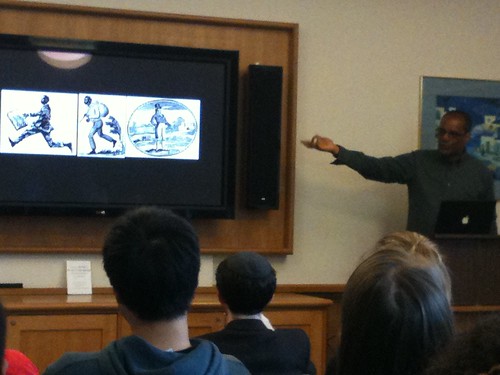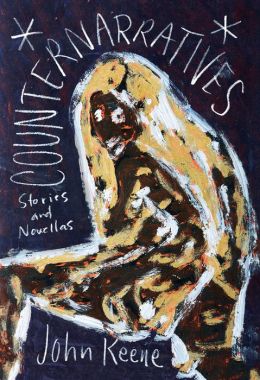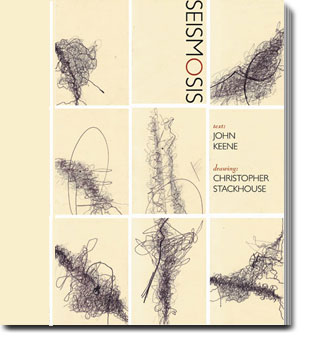 |
| Christopher Cozier (b. Trinidad 1959). Tropical Night, 2006–present. Ink, pencil, stamps. Two hundred drawings, each 9 x 7 in. (22.9 X 17.8 cm). Courtesy of the artist, from Brooklyn Museum site |
I remembered his name--though I did not recall his work and hadn't heard him speak about it then--from a previous exhibit at the university, Out of Sight, which Krista Thompson and another colleague, Huey Copeland, organized in 2007 on the 200th anniversary of the abolition of slavery (1807-2007). As part of his presentation, which he divided into three parts, he talked about the evolution of his work over the last few years and how "curatorial enterprises" had shaped it and contributed to what he called its "moving locations." What became clear is that there are throughlines between the earlier work and more recent projects, with certain visual vocabularies, such as iconic or fragmented bodies; forms, such as flags; and discourses, such as the bureaucratic, repeatedly coming to the fore. Among the ironies he noted was that as a young educated Trinidadian one of his parents' hopes for him was a government job (which would have meant security in the old days), but he chose a career in the arts instead, yet has returned to symbols of bureaucracy, from his use of office furniture and implements, to his abiding interest in rubber stamps, over and over, which is perhaps more ironic in a post-colonial state.
He showed a number of pieces, such as a fenced in winners' platform that he debuted in Denmark, but then had to rethink when restaged in the context of Haiti, and which provoked very different interactions with participants, and the same was true of an installation piece/sculpture that involved Chinese rules strung from a line, which in Haiti also led to very different responses (such as, people borrowed/took the rulers). Other wonderful, simple-yet-fiendishly complex projects, which Cozier scales up and down depending upon the circumstances, included his Boxes of Fear (2006), which began as tiny boxes stamped with "FEAR" as if manufactured in the US, but which he expanded to a 2000-box installation, on pallets, ready for export, in a show in Puerto Rico. He also talked about a very recent project involving benches, which he drafted--he is a very gifted draftsman--and then turned into a rubber stamp, but which have since morphed into various kinds of benches, paper and otherwise, which can be assembled, transported, and rethought depending upon the context and circumstances.
Part of the delight in hearing him talk was seeing how he transformed each of these kernels of ideas and concepts, many as he noted originally created in his notebooks--his mobile studio--into various related projects. What was also fascinating to learn about was his work with Alice Yard and how that was informing his practice, both as an artist and as a curator, how he was rethinking the local in relation to Trinidad specifically, and the Caribbean more broadly, in relation to the global artworld and capital flows, how social media had become a new and powerful means for communication across the islands and the Diasporas (Caribbean, African, South Asian), but also for disseminating work. He described one digital catalogue he and others prepared for the Wrestling show, and how it was downloaded 33,000 times shortly after being posted. To quote him: "With the Internet a whole new way of reading the work comes into being," and a new discursive space is inaugurated and formed. Also, as he said, with social media, the "eyeline" for the visual changes. I have been thinking around this in relation to the literary, but his statement crystallized something for me as I am now trying to write about the relationship between the digital and black literary practice.
Cozier talked about so many other things I cannot even hope to capture them here, but I'll end by noting that during the Q&A with Thompson and the audience, one of the points he focused on was "space" itself, both in terms of artistic practice and in terms of the space of Alice Yard as an exhibition and performance site. As with so much in the Americas the house and grounds, like the neighborhood and suburb, Woodbrook, where Alice Yard is located, have a history, and that is part of what Cozier and those affiliated with the center have been unearthing or reconstructing. That is to say, there's a lineage and heritage, a cultural (and sociopolitical DNA) in this space, belonging to the family of Sean Leonard, that ties it to earlier and older artistic traditions. What Cozier also noted was that it is space suited to local arts and artists, as opposed to the sorts of sites that exist all over the globe, and which could be interchangeable, important as they are, for the global art trade. Instead, Alice Yard is, he pointed out, a space for social interactions, local, trans-Caribbean, trans-Atlantic, and yes, in some cases, global, but permeable, mutable, organic, which people of all kinds can enter and interact with. Key to all of this is the idea of action--action defines the space, which changes with it.
If you click on the Alice Yard link you can find out more about what's happening there and visit if you're passing through Trinidad. Cozier also blogs, at Visual Matters, and on there you can find lots of images of his work, as well as his critical thoughts. Small Axe is also a site to check out, for current critical Caribbean thought and practice in a range of media; Cozier oversees its sxspace blog platform, which features very up-to-date material on projects throughout the Caribbean and neighboring spaces (like Suriname). An artist, curator and thinker to follow, no doubt.
 |
| Christopher Cozier talking about his work |
+++
On the personal front, C mentioned that we'd received a sizable number of the May/June 2012 edition of Adbusters' magazine, focusing on Regime Change. Though I agree with and support Adbusters' work, I wasn't sure what was going on until I remembered that they'd requested to use photo I'd snapped in the New York subway a summer ago and then posted to Flickr, and now it was appearing in this edition!
Oddly enough I'd seen this issue in a store, flipped through but had missed the photograph I took, which looks like it might serve as a lead into one of the magazine's sections. I told myself I'd buy it the next time I was in the store, but it appears I won't have to.
 |
| The cover |
 |
| My photo in the issue (© John Keene) |
I still don't have a copy of the issue yet, but I look forward to flipping through it soon. I think this is a first for me, at least as an adult and with my permission, having a photograph featured in a magazine, and of all magazines, Adbusters no less. I won't be quitting my day jobs, but it is nice to see that even a snapshot can gain a wider audience now and then.
If you want to order copies of this or any issue of Adbusters or learn more about the organization, which played an initiatory role, in part, in the Occupy movements in the US and which seeks to do exactly as the image above says, to stop a system that forces people "to live like rubbish" by functioning as a "network of culture jammers and creatives working to change the way information flows, the way corporations wield power, and the way meaning is produced in our society," you can click on the links above, or visit here.











